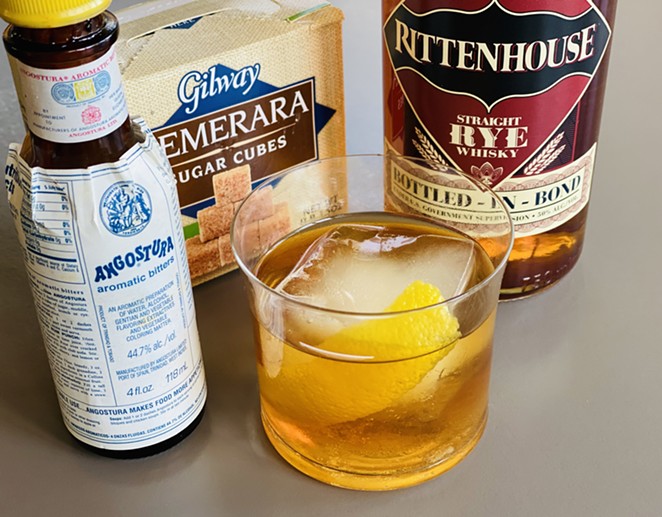The Old Fashioned is one of the first build-in-the-glass cocktails — and one of the first cocktails, period. Once simply called the Whiskey Cocktail, this classic is certainly a foundational drink for any aspiring home bartender. Some even claim it’s a rum forbear.
Just because it’s a Genesis creation doesn’t mean this initially simple combination of whiskey, sugar, bitters, water and sometimes a splash of curaçao or a bit of muddled orange peel is settled doctrine. At one point, the Old Fashioned morphed into a “veritable fruit cocktail with oranges, orange juice, cherries and sometimes a piece of pineapple … an ugly slurry that has nothing to do with the original drink,” according to the tome Vintage Spirits and Forgotten Cocktails. Other purists suggest the fruit was a way to disguise inferior liquor.
Origins aside, the key to making a quality Old Fashioned is to start with good booze, preferably 100-proof rye — my preference — or bourbon. Actually, start with one raw brown sugar cube in the bottom of an aptly-named Old Fashioned glass, pour in about ¼ ounce of cold water — some recipes call for soda water — add two dashes of Angostura bitters and muddle with whatever implement you have. A wooden spoon will do.
Once done muddling, pour in two ounces of your whiskey of choice, then add one large ice cube and swirl it. If you insist on a fancy big ice cube like the ones at craft-cocktail bars, invest in a silicon mold that will turn out cubes about 1¼ inch per side. From there, simply twist a piece of lemon skin over the drink and drop it in.
Beyond Whiskey
Once you’ve mastered the technique — and you should — feel free to move on to other base spirits. Old Tom gin and brandy are classic variations, while reposado or añejo tequila make for a mean and more contemporary twist.
Here’s another option: the Oaxacan Old Fashioned, developed by New York’s now-shuttered Death & Co. The cocktail uses one-and-a-half ounces of tequila, a half-ounce of mezcal, a teaspoon of agave nectar and two dashes of Angostura stirred with ice and complemented with a twist of orange peel.
Almost as simple a drink is the classic, equal-parts Negroni. While some recipes call for stirring the gin, sweet vermouth and Campari in an ice-filled mixing vessel for transfer to an Old Fashioned glass, the simplest method is just to pour the ingredients into the final container with ice, stir and sip. Some like to play a little with the proportions, of course. I happen to prefer more gin and less vermouth. And there are myriad other variations, including a Bianco. Give that a Google and have some fun.
Layers, Flutes and More
Stirring and shaking are classic means of both diluting the alcohol and incorporating all the parts of a cocktail. However, some drinks are built in the glass precisely to create layers. A book called The Architecture of the Cocktail, which I received from a talented bartender friend with a degree in architecture, offered up one such cocktail — the Tequila Sunrise.
With that name, the layers make real sense. Put three or so large ice cubes into a highball glass, add one-and-a-half ounces of silver tequila, allowing it to settle into the bottom. Next, slowly pour in four ounces of fresh orange juice. Then, over the back of a spoon, slowly drizzle in a quarter-ounce of grenadine. Toast the dawn.
A different kind of glass altogether, the flute, is required for Champagne cocktails, a kind of bubbly version of the Old Fashioned — at least as far as the sugar cube is concerned. The essential Speakeasy cocktail book offers a great version. Pour a half-ounce of Grand Marnier into a flute and slowly top off with about five ounces of chilled Champagne. Saturate a sugar cube with Angostura and carefully drop it into the flute. Twist a swath of lemon peel over the drink, then discard the spent citrus.
I’m generally not a fan of drinks with crushed ice, but, hey, it’s summer, so why not a Caipirinha? This simple cocktail is based on cachaça, a brash distillate of fresh sugar cane that’s the national liquor of Brazil. You could probably substitute an agricole rum for a slightly more refined drink. In your trusty Old Fashioned glass, muddle half a lime, sliced vertically into quarters with two teaspoons of sugar. Add two ounces of cachaça, fill with crushed or cracked ice and serve. You may notice a resemblance to a rum-based mojito, which replaces the muddled lime and sugar with mint leaves and simple syrup. And why not give that one a go while you’re at it?
So many restaurants, so little time. Find out the latest San Antonio dining news with our Flavor Friday Newsletter.


